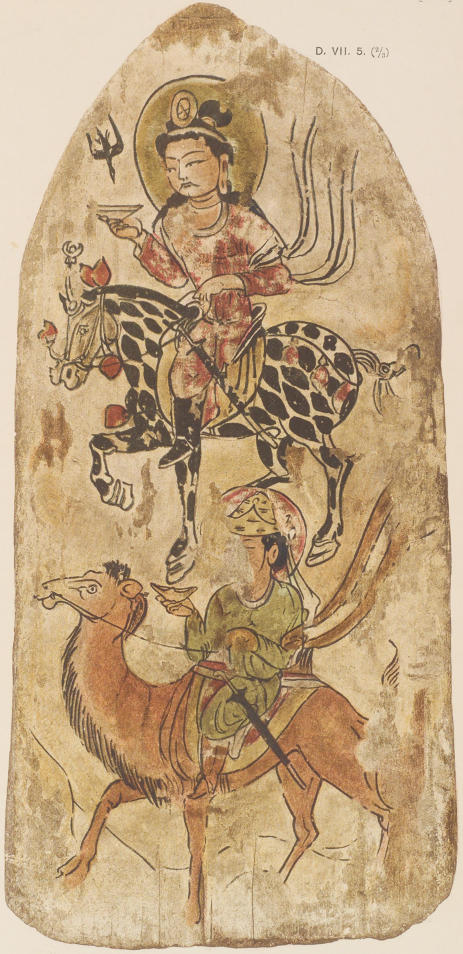Panel of
horseman
and camel-
rider, D. VII.
5.
|
The panel D. VII. 5, of which Plate LIX shows a successful reproduction in colours reduced to a two-thirds scale,
may be mentioned here first, as it illustrates a legend which representations found in the shrines D. II. and D. X. have rendered familiar3.
The panel, which has a rectangular shape, with pointed arched top, is 15 inches high and nearly 7 inches broad.
It shows two figures, both mounted, one above the other.
The upper figure is seen riding on a high-stepping horse and holding in his right hand a patera towards which a bird, more distinctly shown in D. X. 5 as a wild duck, is swooping down in full flight.
The rider, whose handsome youthful face shows an interesting combination of Indian and Chinese features, wears his long black hair tied in a loose knot at the crown, while a yellow band passes round the head holding in front a large elliptical jewel.
Besides the long pink tunic, the rider wears a narrow light scarf which, descending apparently from the back of the head, is curled round both upper arms, while its ends float behind, indicating rapid movement4. The feet are cased in high black boots with felt soles, very much like those still worn by men of means in Chinese Turkestan, and are placed in stirrups. From the girdle hangs a long sword, nearly straight, of a pattern that appears early in Persia and other Muhammadan countries of the East. The horse, which is well drawn even to its legs and hoofs, by its colour-white with large spots of black-curiously recalls the appearance of the piebald 'Yarkandi' horse which until recent times was much fancied by natives of Northern India.
Over a large 'Numdah' or felt cloth it carries a deep and narrow saddle and shows elaborate trappings, for a description of which I may refer to Mr. Andrews' detailed notes in the list of objects.
We could scarcely have wished for a more accurate picture of that 'horse millinery' which in the eighth century evidently flourished throughout Eastern Turkestan quite as much as it does nowadays.
|
Camel-
riding figure
in D. VII. 5.
|
No less interesting is the representation of the second figure below, riding a two-humped camel,
shown in full movement and with striking fidelity to nature.
The rider wears over his short curly hair (partly deleted) a curious sugar-loaf hat, with its broad brim turned up into 'Vandyke' points,
like that of the riding figure seen in D. X. 5 (comp. Plate LXII).
Marks on the hat indicate some spotted fur as its material.
The long and loose-fitting green garment worn by the rider is gathered below the knee into the wide tops of red boots or mocassins without soles,
closely resembling the 'Chāruks' now used throughout the whole of Eastern Turkestan, particularly in the winter months.
While the left hand is guiding the camel by a nose-cord, the right, in the same pose as that of the rider above, raises a shell-shaped cup.
The elaborate fittings of the saddle, and the stirrups, show that the animal best ridden by this personage is meant for a riding camel,
rarely used now in this region, but distinctly referred to by a version of Sung Yün's notice of Khotan5.
Some freely-drawn outlines visible behind the camel's legs are meant to indicate hilly ground or else high ridges of sand, where, indeed,
the camel would be far more in its place.
The nimbus painted round the head of each of the riders plainly shows their holy character,
and the identity of their attitude leaves no doubt as to their connexion with what was evidently a popular local legend.
But to the nature of this legend I have not been able to trace any clue.
3 See above, pp. 248, 261.
4 The fixing of this scarf, corresponding to the ullarīya of Indian Buddhist iconography,
at the back of the head is more clearly indicated in the figures of panels D. VII. I, 6
(see Plates LX, LXI, LXVI).
5 Comp. Rémusat, Ville de Khotan, p. 22 ; also above, p. 170, note 32.
|


